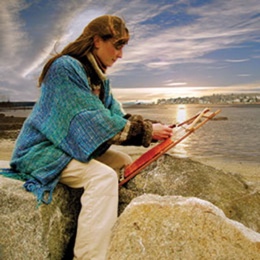
Every work of love is the key to making life beautiful. If we transform what happens in life into something that has a spark of love in it, we can see beauty, humor, and peace. We can share this with our community and that’s the way to create peace in the world.
1. What led you to the mission of being a peace weaver?
I realized I wanted peace inside myself. As we go along in life, we have to learn how to respond to all the events that come our way in this “earth school”. The “curriculum” is what happens to us every day and how we respond to what happens. I look at how I can respond to what is happening every day, create love for my self and others, create peace of mind, and use my weaving as a tool. That is the work that I have been doing for the last forty years.
I created a business called Weaving a Life. I wrote a book called ZATI The Art of Weaving a Life. In that book, I developed seven keyforms. (“The weaving of the keyforms is itself a 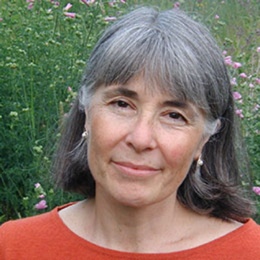 process of deepening awareness through connecting the hands and heart in a journey of self-discovery.”) I designed a little loom from collecting seven sticks on the beach. I started weaving on the beach and sending these projects out to the sea and with prayers and good wishes. This loom is called the journey loom. It started me on this journey of trying to understand what beings peace to us as human beings. I realized that peace is in our minds.
process of deepening awareness through connecting the hands and heart in a journey of self-discovery.”) I designed a little loom from collecting seven sticks on the beach. I started weaving on the beach and sending these projects out to the sea and with prayers and good wishes. This loom is called the journey loom. It started me on this journey of trying to understand what beings peace to us as human beings. I realized that peace is in our minds.
I’m one of those people who have always been a seeker. Since I was a child I thought, “What is the truth?” My father was a minister and my mother was a healer. They had different approaches to truth. I was always wondering which one was right or if there was something else that was true.
I got a degree in education and art. I travelled extensively. I went to a school in Greece and wondered, “What do the ancient Greeks believe?” I became a philosopher, educator, and artist. Eventually I ended up in India studying spirituality. It’s been a real journey of discovery for me. I became a life coach working with people and helping them think about their own lives and journey. The journey is about starting right where you are.
A course that I teach is called, “Weaving A Life Leadership Training”. It’s about doing a life review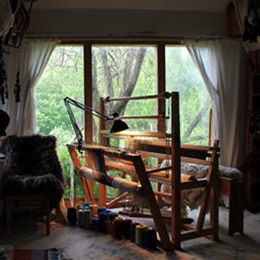 to bring up your values – what’s really important to you. We can discover what is important by going through life step-by-step and reviewing things you love about each person (your mother, your father, your best friend) and things you love about your life. Your main values come out of this. The seven-stick journey loom is like your body or the vehicle that you use to get around in this world. The warp or vertical threads on the loom are your values. The center thread is red and it represents where your center is and how you center yourself. The weft represents your daily actions.
to bring up your values – what’s really important to you. We can discover what is important by going through life step-by-step and reviewing things you love about each person (your mother, your father, your best friend) and things you love about your life. Your main values come out of this. The seven-stick journey loom is like your body or the vehicle that you use to get around in this world. The warp or vertical threads on the loom are your values. The center thread is red and it represents where your center is and how you center yourself. The weft represents your daily actions.
That’s how we weave our life. Every moment, we weave our life into actions based on what we believe and value. At the very end, we find the tapestry of our life.
2. What does this mission mean to you?
We recently started the EarthLoom Foundation which supports EarthLoom Projects. The projects 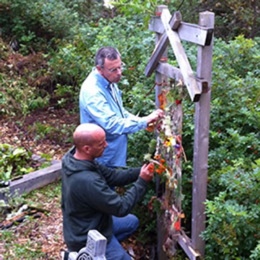 are ways to think about peace in the community. We have people working with orphans in Peru, and others in the Ukraine, and in Cambodia. They get together with large seven-stick looms and weave together as a community. We’ve also worked with women who are cancer survivors. Everyone works together to think about each other’s needs. Weaving these projects always brings us together in a very special way.
are ways to think about peace in the community. We have people working with orphans in Peru, and others in the Ukraine, and in Cambodia. They get together with large seven-stick looms and weave together as a community. We’ve also worked with women who are cancer survivors. Everyone works together to think about each other’s needs. Weaving these projects always brings us together in a very special way.
3. What was your best day as a peace weaver?
There was a day recently when I was invited to come to a school on an island. It’s a K through 8th grade school. The kids were isolated and wanted to get to know each other and students on four other islands. They created a day of friendship weaving. One of the people who worked on one island said he would build the loom. We have a video that explains how to build the loom and gives the plans.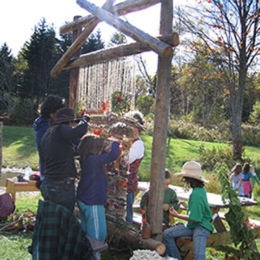 We had a whole day of weaving with all the children from these five different islands such as Frenchboro, Matinicus, and Monhegan, Maine.
We had a whole day of weaving with all the children from these five different islands such as Frenchboro, Matinicus, and Monhegan, Maine.
It was amazing to have these beautiful island children weave with their families and teachers. We began by thinking about what our weaving would look like. We ended up with this beautiful friendship weaving that was circulated between all of the schools. It turned out that because of this day and the friendship weaving, the students realized that they could communicate on the computer to all the other schools. You never know what will come out of a weaving. Now they all have classes together on the computer.
4. What was your worst day as a peace weaver?
I never have had a worst day. Every day is just a new part of the “curriculum” of what I need to look at today in my life, such as what’s the next opportunity to do something great? Whether it’s sickness or some catastrophe, life in many ways is a large catastrophe. All you have to do is look at the newspaper. Zorba the Greek was one who called life a catastrophe. (Zorba: “I’m a man, so I married. Wife, children, house, everything. The full catastrophe.”) Plato and Aristotle had this idea as well.
It’s really exciting to see that we are all in the process of solving problems. Any worse day is a major opportunity to transform the negative pieces into, “How can this be some part of my lesson today? What am I learning from this?” It’s part of my journey on this planet.
5. How did you survive your worst day?
Resilience is the key to how to approach our lives. We see that everything that happens has some meaning. Every work of love is the key to making life beautiful. If we transform what happens in life into something that has a spark of love in it, we can see beauty, humor, and peace. We can share this with our community and that’s the way to create peace in the world.
I encourage you to find what’s good about your life. When you do that, you feel good and you can be with your family and work in a way that brings joy to everyone around – because you are happy.
- « Previous person: Chuck C. Nguyen
- » Next person: Liza Gardner Walsh